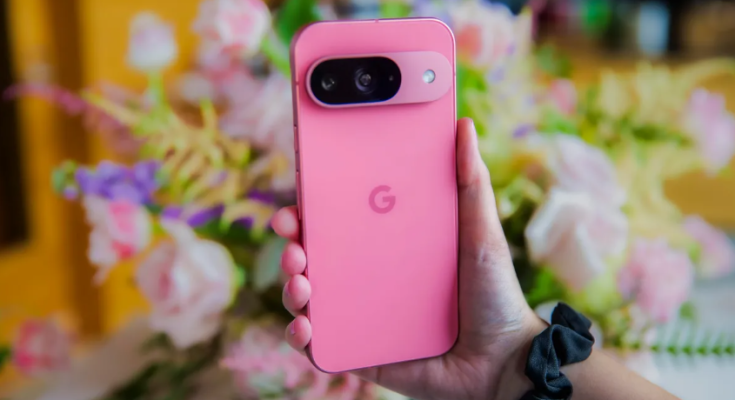Google Pixel 9 First Take: Smarter Software Takes the Spotlight
The Pixel 9 is loaded with new AI features, along with a fresh design and a better ultrawide camera. But it’s also more expensive than last year’s Pixel 8.
![]()
The Pixel 9, which Google announced on Aug. 13 alongside the Pixel 9 Pro, 9 Pro XL and 9 Pro Fold, reflects a makeover of Pixel devices. All three phones have a fresh look, hardware improvements and, of course, an even bigger dose of artificial intelligence.
In many ways, the standard $799 Pixel 9 — Google’s cheapest phone in the bunch that’s $100 more than last year’s Pixel 8 — feels like a routine upgrade. It comes with a new Tensor G4 processor and more memory, a higher resolution ultrawide camera, a bigger battery and a slightly larger screen.
Read more: Google Pixel 9 Review: Chock-Full of AI. But That’s Not What Makes It Great
But more importantly, it’s a bigger showcase of how Google thinks generative AI could be useful on our phones. AI is sprinkled throughout the operating system in new ways, from AI-generated weather summaries to a new image generation app for creating pictures on the fly.
More from Made by Google
Google’s approach to AI on phones is as important as ever considering it’s facing increased competition from Apple, which plans to roll out its own AI Apple Intelligence features in beta this fall. Apple and OpenAI, perhaps Google’s two biggest rivals, are also teaming up to bring ChatGPT integration to the iPhone, all while Google is weaving its Gemini assistant more tightly into Android smartphones. If that wasn’t enough of a reason for Google to emphasize its AI ambitions, OpenAI just announced its own AI search engine called Search GPT, which many are perceiving as being a direct competitor to Google.
At the same time, generative AI is only bound to become more prevalent on phones. The International Data Corporation predicts shipments of gen AI phones, or phones with specific specifications for running on-device generative AI models, will grow 364% year-over-year in 2024.

The Pixel 9’s new AI and software features

While the AI tools Google introduced with Pixel 8 were primarily focused on photo editing, the Pixel 9’s new features are about making the operating system feel more intuitive. (Of course, there are some new photography-related tricks too). These features are available across the Pixel 9 lineup since all of the new phones run on Google’s Tensor G4 processor. The standard Pixel 9 also includes 12GB of RAM rather than the Pixel 8’s 8GB, which should boost general performance and help support the phone’s new AI features.
Among the standout new features is an app called Pixel Screenshots, which makes it possible to ask questions about screenshots stored on your phone. That might not sound too exciting, but think about how many times you may have screenshotted something for later reference — perhaps a Wi-Fi password to your Airbnb or an address from a text message. The Pixel Screenshots app lets you search for those individual bits of information as you need them, kind of like the Ask Photos feature for Google Photos that the company announced at Google I/O.
What’s more interesting, though, is the way Google claims its software can infer context based on the image. For example, if you’ve taken a screenshot of a digital poster for an upcoming event (like a concert or festival), the company claims it can distinguish between different times listed on the poster, such as the event itself and the ticket sale date.

Google’s new Pixel phones are also getting a tool for creating images based on prompts called Pixel Studio. Just type in a description and the app will generate an image. There are also a handful of starter prompts based on themes if you’re stuck on where to begin. For example, a “retro video game” section may include prompt ideas such as “pixel art retro video game of a misty forest.” Apple is launching a similar tool called Image Playground as part of its Apple Intelligence suite of features.
The weather app will now show AI-generated weather summaries, and you’ll have the option to record a phone call and view a summary of the conversation in the phone app.
Building on last year’s Magic Editor, which can remove or change objects in photos, Google is introducing Reimagine. Instead of just having the AI decide how to change a certain element of a photo, you can type in a prompt to get a desired result. For example, I highlighted the floor of an outdoor balcony in one photo and told Google to “reimagine” it as a sandy beach.
But the new camera feature that I found most intriguing was Add Me, which uses augmented reality to help you take a group photo. The process involves taking two photos: A first photo, and then a second shot in which the original photographer swaps with someone else to join in the group photo. When snapping the second photo, the second photographer will see an AR overlay guiding them to help position the new person (the first photographer) on where to stand so that the photo looks natural. The software then combines both of those photos together to create an image where everyone is in the picture.
I have to admit, I was surprised to see how well the AR functionality works when I tried this during a demo ahead of Google’s event. As I held up the phone, I saw a digital overlay of myself positioned almost exactly where I was just standing a second ago. In most cases, it’s probably still easier and less awkward to just ask someone to take the photo for you. But I do think Add Me is more practical and more genuine in its intention than Best Take, the feature introduced last year that can make it look like everyone is smiling in a photo.
Overall, the Pixel 9’s new software features feel like a step toward making Google’s Pixel software more intelligent. But I don’t think these features alone are going to be enough to motivate those who are happy with their current phone to upgrade. However, I do think Google’s approach, particularly the Pixel Screenshots app and the summarization features, are more practical on an everyday basis than some of Samsung’s Galaxy AI features.
Pixel 9 design and other hardware upgrades

The first thing I noticed when picking up the Pixel 9 was its striking new design with flat edges and more pronounced camera bar. It’s different enough to feel new without losing the signature Pixel look that Google has established in recent years. The camera isn’t just an aesthetic change though; Google is bumping the ultrawide camera’s resolution to 48 megapixels, up from 12 megapixels on last year’s model.
Google’s Pixel 9 phones also have satellite connectivity, a feature that’s been present on iPhones since the iPhone 14 generation in 2022. That means the Pixel 9 series will be able to contact emergency services without cellular or Wi-Fi connectivity.
Battery life should also get a boost over the Pixel 8 since the Pixel 9 has a 4,700-mAh capacity compared with its predecessor’s 4,575-mAh battery. But of course, there’s a chance using those new AI features heavily could put more strain on the battery.
All of Google’s new phones will get new versions of Android for seven years, just like the Pixel 8 family. The biggest differences between the Pixel 9 and the Pro models come down to size options (the Pro comes in 6.3- and 6.8-inch sizes), its triple camera setup that includes a telephoto camera in addition to the wide and ultrawide lenses, additional video features like Video Boost for enhancing video footage in the cloud up to 8K, a 42-megapixel selfie camera fand extra memory (16GB of RAM instead of 12GB). But you can learn more about the differences in the table below.
The Pixel 9 seems like it could be a promising step forward for those upgrading from an older Pixel phone. The biggest question will be whether Google will bring its new AI features to older Pixel devices as it’s done in years past. The answer could be crucial in determining how big of an upgrade the Pixel 9 truly is.
Google Pixel 9 vs. Pixel 9 Pro vs. Pixel 9 XL
| Google Pixel 9 | Google Pixel 9 Pro | Google Pixel 9 Pro XL | |
| Display size, tech, resolution, refresh rate | 6.3-inch OLED; 2,424 x 1,080 pixels; 60 – 120 Hz variable refresh rate | 6.3-inch LTPO OLED; 2,856 x 1,280 pixels; 1-120Hz variable refresh rate | 6.8-inch LTPO OLED; 2,992 x 1,344 pixels; 1-120Hz variable refresh rate |
| Pixel density | 422 ppi | 495 ppi | 486 ppi |
| Dimensions (inches) | 6 x 2.8 x 0.3 in | 6 x 2.8 x 0.3 in | 6.4 x 3 x 0.3 in |
| Dimensions (millimeters) | 152.8 x 72 x 8.5 mm | 152.8 x 72 x 8.5 mm | 162.8 x 76.6 x 8.5 mm |
| Weight (grams, ounces) | 198g (7 oz.) | 199g (7 oz.) | 221g (7.8 oz) |
| Mobile software | Android 14 | Android 14 | Android 14 |
| Camera | 50-megapixel (wide), 48-megapixel (ultrawide) | 50-megapixel (wide), 48-megapixel (ultrawide), 48-megapixel (5x telephoto) | 50-megapixel (wide), 48-megapixel (ultrawide), 48-megapixel (5x telephoto) |
| Front-facing camera | 10.5-megapixel | 42-megapixel | 42-megapixel |
| Video capture | 4K | 4K | 4K |
| Processor | Google Tensor G4 | Google Tensor G4 | Google Tensor G4 |
| RAM/storage | 12GB RAM + 128GB, 256GB | 16GB + 128GB, 256GB, 512GB, 1TB | 16GB + 128GB, 256GB, 512GB, 1TB |
| Expandable storage | None | None | None |
| Battery | 4,700 mAh | 4,700 mAh | 5,060 mAh |
| Fingerprint sensor | Under display | Under display | Under display |
| Connector | USB-C | USB-C | USB-C |
| Headphone jack | None | None | None |
| Special features | Satellite SOS; 7 years of OS, security and Pixel feature drops; Gorilla Glass Victus 2 cover glass; IP68 dust and water resistance; 2,700-nit peak brightness; 45W fast charging (charger not included); 15W wireless charging with Google Pixel Stand (2nd gen); 12W wireless Qi-charging; Wi-Fi 6 and Wi-Fi 7; NFC; Bluetooth 5.3; Dual-SIM (eSIM + nano SIM); Add Me; Best Take; Magic Eraser; Magic Editor | Satellite SOS; 7 years of OS, security and Pixel feature drops; IP68 dust and water resistance; Video Boost with 8K Upscaling; Macro Focus on ultrawide; Gorilla Glass Victus 2 cover glass; 3,000-nit peak brightness; 45W fast charging (charger not included); 15W wireless charging with Google Pixel Stand (2nd gen); 12W wireless Qi-charging; Wi-Fi 6 and Wi-Fi 7; NFC; Bluetooth 5.3; Dual-SIM (eSIM + nano SIM); Add Me; Best Take; Magic Eraser; Magic Editor | Satellite SOS; 7 years of OS, security and Pixel feature drops; IP68 dust and water resistance; Video Boost with 8K Upscaling; Macro Focus on ultrawide; Gorilla Glass Victus 2 cover glass; 3,000-nit peak brightness; 45W fast charging (charger not included); 15W wireless charging with Google Pixel Stand (2nd gen); 12W wireless Qi-charging; Wi-Fi 6 and Wi-Fi 7; NFC; Bluetooth 5.3; Dual-SIM (eSIM + nano SIM); Add Me; Best Take; Magic Eraser; Magic Editor |
| US price starts at | $799 (128GB) | $999 (128GB) | $1,099 (128GB) |
| UK price starts at | Converts to £637 (128GB) | Converts to £783 (128GB) | Converts to £861 (128GB) |
| Australia price starts at | Converts to AU$1,211 (128GB) | Converts to AU$1,514 (128GB) | Converts to AU$1,666 (128GB) |
Not Just AI: 14 Changes Coming Soon to Android 15




